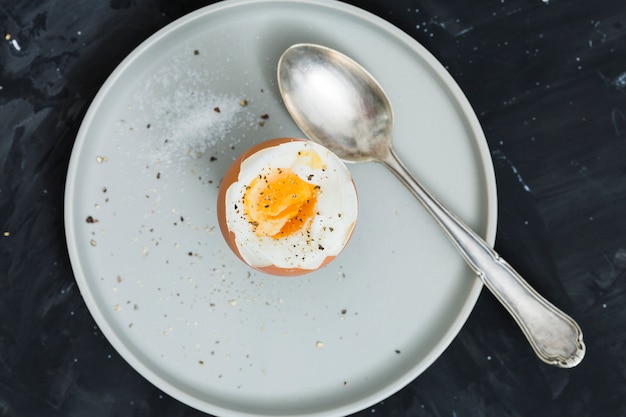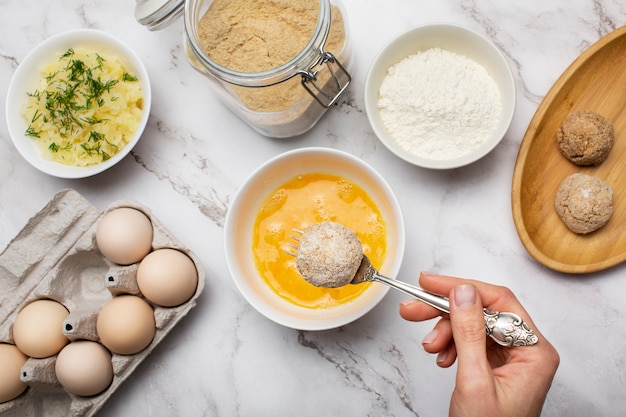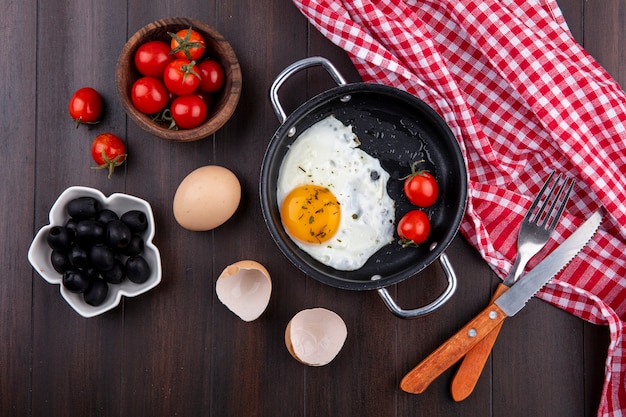Let’s face it, poached eggs have a certain mystique. They’re the kind of breakfast you see at fancy cafes, and they always look so effortlessly elegant. But the truth is, poaching an egg isn't a culinary black art; it’s a technique that anyone can master with a little practice and the right tips.
I remember the first time I tried to poach an egg. It was a disaster! The egg white ended up all over the pan, and the yolk was hard as a rock. But after a few more attempts, I figured out the secret to getting those perfect poached eggs – the ones with velvety, creamy yolks and gently set whites.
So, buckle up, because today we’re going on a journey into the world of poached eggs. We’ll explore the ins and outs of the process, from choosing the perfect egg to mastering the art of the swirl. By the end of this guide, you’ll be a poached egg pro!
(Part 1) Choosing Your Eggs: The Foundation of a Great Poached Egg

Before we even start talking about the actual poaching process, let's talk about the most important ingredient: the eggs themselves.
Freshness Matters
Have you ever cracked open a really old egg and seen that pale, watery yolk? It's a sign of a stale egg, and those are definitely not ideal for poaching. You want a fresh egg with a vibrant, deep orange yolk and a thick, firm white. That’s the key to a creamy, satisfying poached egg.
Now, finding perfectly fresh eggs can be tricky, especially if you live in a city and rely on grocery stores. If you can’t get fresh eggs from a local farm, make sure the ones you buy are as close to their “best before” date as possible.
The Size of the Egg Matters
You might think this is a joke, but the size of your egg actually makes a difference. For poaching, medium-sized eggs are the sweet spot. They're large enough for a generous yolk, but not so large that they become unwieldy. You want a nice balance between yolk and white, and medium-sized eggs deliver just that.
(Part 2) Mastering the Poaching Technique: Step-by-Step

Now, let’s get down to the nitty-gritty. It's time to poach those eggs!
The Right Pot: A Wide and Deep Companion
First, you need the right equipment. A saucepan with a wide base is essential for poaching. You don’t want to crowd those eggs in a tiny pot; you want them to have space to cook evenly and gently. A wide base also helps the water circulate better, which is key to creating a consistent temperature.
And don’t forget about the depth. Make sure your saucepan is deep enough so the water covers the eggs completely. I usually use a 18cm saucepan, and it’s worked flawlessly for years.
The water temperature: The Gentle Simmer
Now, here’s where things get a little technical. You want the water to be simmering gently, not boiling furiously. Picture a bubbling brook, not a raging river. Boiling water will make your egg whites tough and stringy, which can ruin the whole experience.
The Magic Trick: Vinegar to the Rescue
This is one of my favorite tips, and it truly changes the game. Adding a splash of vinegar to the water helps the egg whites coagulate faster, forming a neater, more compact poached egg. It's a small step that makes a huge difference. Just a tablespoon or two is all you need.
(Part 3) Poaching Your Egg: The Art of the Swirl

Now, it’s time to put your skills to the test. This is where the magic happens.
Crack Gently, Swirl Vigorously
Crack your egg gently into a small bowl. Remember, you’re aiming for a perfectly intact yolk, so be careful not to break it. Now, it’s time for the whirlpool. Gently swirl the water in your saucepan, creating a circular motion. This creates a tiny “nest” for your egg white, preventing it from spreading out too much.
A Gentle Descent into the Water
Carefully slide your egg into the center of the whirlpool, ensuring the yolk is submerged. You want the egg to gently settle into the water, not create a big splash.
The Waiting Game: Patience is Key
Here's where patience comes in. Allow the egg to simmer in the water for about 3-4 minutes, depending on how you prefer your yolk. For a runny yolk, 3 minutes is perfect. For a firmer yolk, go for 4 minutes.
Ready to Serve: Gently Lift and Admire
When your egg is ready, gently lift it out of the water using a slotted spoon. Don't worry if the egg white looks a little wobbly, that’s just part of the charm!
(Part 4) Perfecting Your Poach: The Fine-Tuning Details
Let’s delve deeper into those details that can make the difference between a good poached egg and a truly perfect one.
The Egg White Trick: Creating a Neater Nest
Remember how we talked about the egg whites spreading? Sometimes, you might end up with a slightly messy egg. To combat this, try swirling the water in the saucepan again right before you add the egg. This gives the egg white a little more space to set nicely and prevents it from spreading out too much.
The Salt Game: A Touch of Flavour
Adding a pinch of salt to the water is a small step that can add a subtle depth of flavour to your poached eggs. It’s like a whisper of seasoning that elevates the whole experience.
The Temperature Test: A Foolproof Method
Want to know for sure if your poached egg is cooked perfectly? Here’s my secret weapon. Gently press a fingertip against the white. If it feels firm and not wobbly, it’s ready. It’s like a little culinary handshake!
(Part 5) Serving Your Poached Eggs: Transforming from Humble Egg to Delicious Dish
Alright, now it’s time to enjoy your hard-earned poached egg!
The Classic Toast: Simple, Satisfying, and Always a Winner
For a breakfast that's simple, satisfying, and always a winner, serve your poached eggs on a piece of toasted bread. Add some butter, salt, and pepper, and you’ve got yourself a culinary masterpiece.
The Fancy Feast: Adding a Touch of Elegance
For a more elegant touch, try serving your poached eggs on a bed of creamy spinach with a sprinkle of parmesan cheese. It’s a light and flavorful meal that’s perfect for a weekend brunch.
The Savoury Delight: A Hearty Meal Option
For a savoury kick, try adding your poached eggs to a bowl of pasta with a simple tomato sauce. It’s a quick and easy meal that’s both delicious and satisfying.
(Part 6) Variations and Extras: Beyond the Basics
Now, let’s explore some fun variations to take your poached eggs to the next level.
Poached Eggs with a Twist: Adding Flavour and Texture
Feeling adventurous? Try adding different ingredients to your poached eggs for a unique flavour experience. Here are a few ideas to get you started:
- hollandaise sauce: For a classic brunch favourite, add a dollop of homemade hollandaise sauce.
- smoked salmon: For a luxurious touch, add a slice of smoked salmon on top of your poached egg.
- Spicy Salsa: For a burst of flavour, add a spoonful of your favourite salsa.
- Avocado: For a healthy and delicious option, add some mashed avocado on top of your poached egg.
Beyond the Plate: A Versatile Ingredient
Poached eggs are a versatile ingredient that can be used in many different dishes. Here are a few ideas:
- Salads: Add a poached egg to your favourite salad for a protein boost and a creamy texture.
- Soups: A poached egg can add richness and creaminess to a hearty soup.
- Sandwiches: Poached eggs make a delicious filling for sandwiches, especially with avocado and tomato.
(Part 7) Poached Egg Troubleshooting: Solving Common Problems
We’ve all been there. Those moments when your poached egg decides to become a culinary nightmare. Let’s tackle some common challenges and how to fix them.
The Flat Egg: Spreading Out Too Much
Sometimes, the egg white spreads out too much, creating a flat, unappealing egg. This happens because the water wasn’t hot enough, or you didn’t swirl the water enough to create a “nest” for the egg. The solution is simple: make sure the water is simmering gently and swirl it a little more vigorously before adding the egg.
The Rubber Egg: Overcooked and Tough
This is the worst, right? You pull your egg out of the water, and it’s rubbery and hard. This usually happens when the water was too hot or the egg was cooked for too long. The fix? Make sure the water is simmering gently, not boiling furiously. And use the temperature test to check the egg’s firmness before removing it from the water.
The broken yolk: A Culinary Heartbreak
A broken yolk is a real bummer. This usually happens when you crack the egg too forcefully or try to add it to the water too quickly. It’s a common problem, but it’s easy to fix. Try cracking your egg into a small bowl before adding it to the water, and gently slide the egg into the water, avoiding any sudden movements.
(Part 8) FAQs: Clearing Up Your Questions
Let’s clear up some common questions about poached eggs.
1. Can I Poach an Egg in the Microwave?
Short answer: no. Microwave poaching is a recipe for disaster. It's not the right environment for a perfect poached egg. The water in the microwave gets unevenly hot, and the egg won't cook properly. Stick to the stovetop, and you'll be rewarded with a delicious poached egg.
2. Do I Need Special Equipment?
You don’t need any fancy gadgets to poach an egg. All you need is a saucepan, a slotted spoon, and vinegar. But if you’re feeling fancy, you can try using a poaching pan or a ring mold. These tools can help you create a more perfectly shaped egg.
3. What if I Don’t Like Vinegar?
No worries! You don’t have to use vinegar to poach an egg. It just helps the egg white set faster and creates a neater shape. If you don’t have vinegar, you can try adding a pinch of salt to the water. It won't have the same effect as vinegar, but it will help the egg white set a bit faster.
4. How do I Know if My Egg is Done?
The best way to tell if your egg is done is by gently pressing a fingertip against the white. If it feels firm and not wobbly, it’s ready. For a runny yolk, you can poach it for about 3 minutes. For a firmer yolk, poach it for about 4 minutes.
5. What if My Egg White Looks Stringy?
Sometimes, the egg white can get stringy if the water is too hot or if the egg is overcooked. To avoid this, make sure the water is simmering gently, not boiling furiously. You can also try adding a pinch of salt or vinegar to the water to help the egg white set faster.
(Part 9) Beyond the Basics: Pro Tips for Poached Egg Perfection
You’ve mastered the basics. Now, let’s take your poached eggs to the next level with some pro tips.
The Art of the Swirl: A Controlled Vortex
It’s not just any swirl, it’s a controlled, gentle vortex. It’s all about giving your egg white a little space to gently set around the yolk, keeping that shape nice and tidy. And don’t stop swirling after you add the egg! Give it a quick twirl every now and then to make sure the white doesn’t stick to the bottom of the pot.
The Egg White Clean-up: Skimming for a Flawless Finish
A bit of egg white floating around can be a bit unsightly. It’s like those stray hairs that always seem to find their way onto your outfit. Fear not! Just use a slotted spoon to gently skim off any stray bits of egg white from the surface of the water.
The Egg Tempering Technique: A Gentle Introduction to Heat
This is a little trick I learned from a seasoned chef. It’s all about controlling the temperature of the egg whites. Instead of just cracking the egg directly into the water, you can gently temper the egg white first. Just crack the egg into a bowl, then scoop out a small amount of the simmering water and slowly drizzle it into the egg white, stirring gently. This will help the egg white set a bit quicker and more evenly.
The Pan-Boiling Method: A Hybrid Approach
Alright, here's a little trick I've been experimenting with. It's like a hybrid between poaching and boiling. You just bring a pan of water to a boil, then reduce the heat to a simmer. Then, crack your egg directly into the pan, ensuring the yolk is completely submerged. Let it cook for about 3 minutes, then gently remove it from the water. It's a little less controlled than poaching, but it's still a good option for a quick and easy poached egg.
(Part 10) A Poached Egg Legacy: Mastering the Art
That’s it! I've shared all my secrets, all my tips, all my tricks! I'm genuinely convinced that anyone can poach an egg perfectly with the right guidance. So go forth, my friends, and conquer the world of poached eggs! And remember, it's all about practice and patience. You'll be whipping up restaurant-quality poached eggs in no time! Now, excuse me, I think I'm craving a perfectly poached egg on toast! Cheers!
Everyone is watching

How to Cook Frozen Lobster Tails Perfectly: A Step-by-Step Guide
RecipesLobster. Just the word conjures up images of lavish meals, special occasions, and a taste of luxury. But let's...

Pigs in a Blanket Cooking Time: How Long to Bake for Perfect Results
RecipesAh, pigs in a blanket. Just the name conjures up images of those delightful little parcels of crispy pastry en...

Pork Fillet Cooking Time: How Long to Cook It Perfectly
RecipesPork fillet, or tenderloin as it's sometimes called, is a real favourite in our house. It's so versatile, and...

The Ultimate Guide to Tender, Juicy Pulled Pork
RecipesRight, let's talk pulled pork. It's one of those dishes that just screams "comfort food," doesn't it? I mean...

The Ultimate Guide to Cooking Delicious Frankfurters
RecipesLet's face it, we all love a good frankfurter. It's a classic, simple, and always satisfying. But let's be rea...
